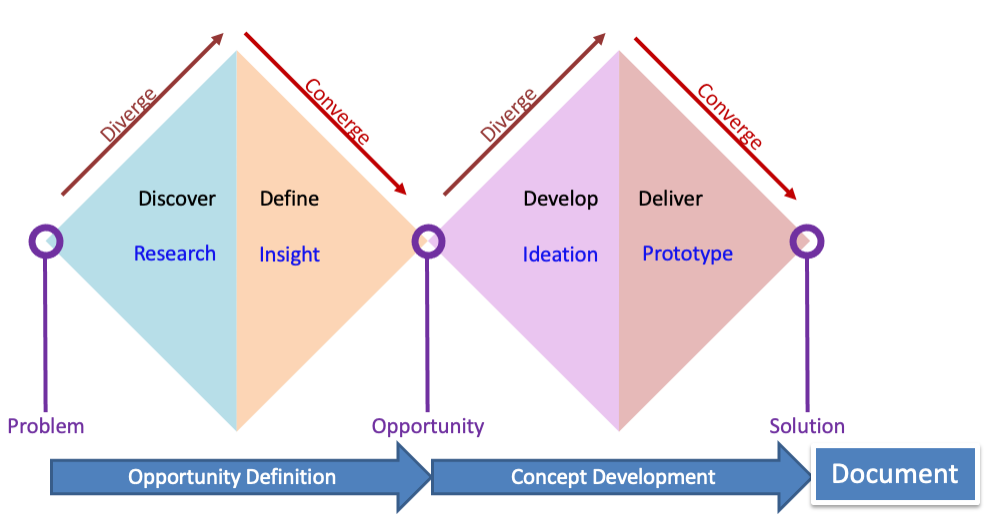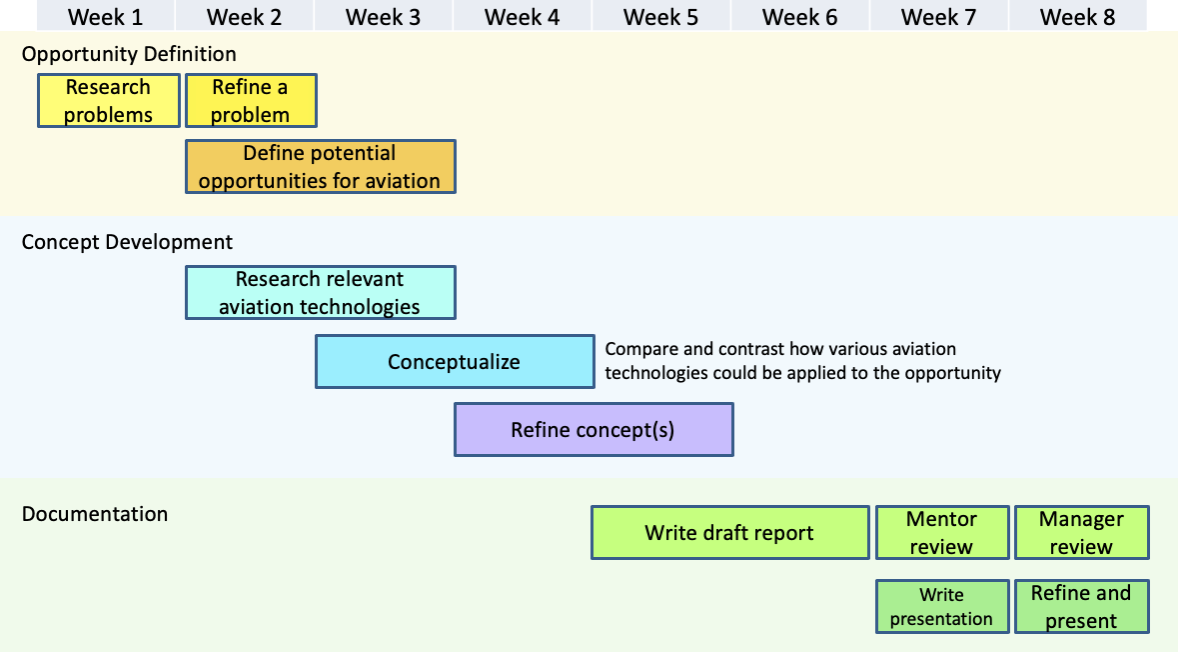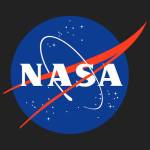Aviation Systems Division Concept Design Experience for High School Students
POC: Shannon Zelinski, NASA Ames Aviation Systems Division, shannon.j.zelinski@nasa.gov
Program Overview
The Aviation Systems Division Concept Design Experience for High School Students has 3 goals:
- Learn about the exciting aerospace opportunities within the Aviation Systems Division at Ames Research Center in the heart of the Silicon Valley.
The Aviation Systems Division performs research and technology development in air traffic management (ATM) and operates some of the Agency’s most advanced flight simulators. In support of NASA’s aeronautics mission, our Division has a long history of inventing ways to increase efficiency and safety within the air transportation system with reduced environmental impact. Our research has led to data-driven technologies to reduce delays, fuel usage, and emissions. In addition to advancing commercial flight systems, NASA aims to transform aviation by making autonomous drones, electric vertical takeoff and landing air taxis, and high altitude long endurance vehicles more accessible and applicable to the general public. Why? To solve future “wicked” challenges everywhere on Earth! For example, the Aviation System Division at Ames is conducting foundational research on UAS Traffic Management and Urban Air Mobility, and is pioneering the integration of drone delivery services and urban air taxis into the airspace system. Students who participate will have the opportunity to engage with mentors and experts from the Aviation Systems Division, attend seminars, and explore these cutting-edge aviation topics. - Develop and propose an aviation concept or application to help solve a current or future “wicked” real-world problem
Wicked problems have many interdependent, hard to define factors making them seem impossible to solve. Defining the problem is often harder than solving it. The United Nations sustainable development goals are good examples of wicked problems. With the help of your mentor, you will employ the inspiring “double diamond design process” to synthesize opportunities for aviation solutions from a wicked problem of your choice. Team members will research nuanced challenges behind several problems of interest, converge on a specific problem definition, and develop concepts for alternative applications of aviation to help solve the problem. Teams will deliver a final report and final presentation to the Aviation Systems Division. Team final reports meeting internal review requirements will be published on the NASA STI Repository for public access. - Gain experience and expand your NASA aerospace networks in a professional virtual team environment.
Virtual teams will be comprised of 6 students and 2 NASA mentors. Students will use personal computers to connect virtually with team members using mutually agreed upon communication and collaboration tools such as Google Workspace, Slack, Zoom/ MS Teams, and email. NASA mentors will routinely tag-up with student teams at least weekly to offer guidance on team progress and identify NASA Subject Matter Experts to consult. Student teams will determine their own meeting schedule and learn to conduct effective meetings fostering inclusion, accountability, and productivity.
Technical Assignment
Investigate existing and emerging aviation technologies, identify a wicked problem the team is passionate about solving, and develop innovative ideas for alternative applications of aviation technologies to help solve the problem and benefit the public. Use the double diamond design process below to help guide your research. The two diamonds represent two main phases of the design process, opportunity definition and concept development, each consisting of an iterative process of divergent expansion of possibilities and convergent filtering and refining.
Opportunity Definition
The first diamond represents the process by which a problem is explored and refined to define an opportunity for innovation. NASA is interested in solving hard problems known as wicked problems. Wicked problems are seemingly impossible to solve because of incomplete, contradictory, and changing requirements that are often difficult to recognize. Because of complex interdependencies, the effort to solve one aspect of a wicked problem may reveal or create other problems. Wicked problems often have high societal impact (e.g., eliminating poverty and hunger, providing good healthcare and well-being, affordable clean water and energy, and climate action). It is important for NASA to try to solve these problems for the betterment of humanity because few people are trying to solve such challenging problems.
Start by selecting and researching one or more wicked problems you find interesting. Read internet articles to stimulate your thinking as you delve into various aspects of the problem. Discuss the problems as a team, make arguments, and vote to focus on a particular problem aspect. Repeat this process of researching individually, discussing findings, and refining until the team converges on a well-defined opportunity. Assess candidate opportunities for desirability, viability, and feasibility to maximize potential impact. Desirability: How many people are affected by this problem and how deep is the pain? Viability: Will the market sustain a solution? Feasibility: Can it be solved? Early in the refinement, focus on the benefit to humankind and team passion and interest around solving the problem. Only later, consider the potential for applying aeronautics to help solve some aspect of the problem. As more specific questions form in your mind, research facts to support your assumptions, or identify subject matter experts to interview to understand the problem better from specific points of view.
Concept Development
The second diamond represents the process by which possible technologies are explored and combined to form a concept to address the selected opportunity. Start by learning as much as you can about aviation technologies and systems and other new trending technologies. Do this by reading internet articles, attending technical seminars or viewing past seminar recordings, and having discussions with mentors and subject matter experts. The Aviation Systems Division has vast experience developing concepts for enabling more efficient and sustainable commercial transport aviation, autonomous drones, electric vertical takeoff and landing taxis, and high-altitude long endurance applications. Brainstorm concept ideas as a team applying different combinations of technologies to see what is possible. Quickly sketch out how the concepts would work and be used and interview potential users for feedback. Dive deeper into researching key supporting technologies to identify any limitations or barriers that still need to be addressed. Perform a more detailed assessment of desirability, viability, and feasibility of the concepts. Compare and contrast competing candidate technologies or concepts.
Program Structure
Time Commitment
Each individual team program will run for eight consecutive weeks within the months of June, July, and August. Student participants are expected to devote approximately half-time (4 hours/day on average) to the program. The exact eight-week time-period for each team is determined by selected applicant availability and preference. Students may miss up to one week of their program due to preexisting commitments. However, they must pre-coordinate with team members to help plan for the absence and determine if some work can be front loaded before the absence or made up after. See below a notional project schedule of when certain activities are expected to be performed within the 8-week program.
Virtual Teams with Mentors
Each team is comprised of six high school students and two volunteer NASA mentors. Participation is entirely virtual and conducted using virtual collaboration tools. Students perform work through a combination of synchronous team discussion and asynchronous individual tasks. Mentors will virtually meet with team members at least weekly to review progress and provide guidance. Team members will set their own synchronous team discussion schedule separate from mentor tag-ups. The notional project schedule above is provided to help teams track progress.
Virtual Seminars
Team members will be invited to optionally join virtual seminars on various aeronautics research topics as well as the NASA Summer Series which includes a wider variety of topics including space and science missions. Team members will also be given access to previously recorded aeronautics research seminars via NASA Box.
Subject Matter Expert Interviews
As the project focus solidifies, the team is encouraged to seek out and interview subject matter experts to provide additional information about the problem space and aeronautics technologies or provide feedback on the concept design. Mentors may be able to identify and arrange meetings with NASA experts within the Aviation Systems Division.
Final Presentation
The team will deliver a virtual final presentation to the Division scheduled for 1 hour during the final week of the program. The presentation should be ~45 minutes with ~15 minutes for questions. Every team member should present a portion of the technical content. In addition, the team should introduce themselves and their interests and share any frustrations or insights encountered throughout the project. Following the presentation, team members will be sent a program feedback form. Each team member who completes and returns the form will receive a certificate of completion for the program.
Final Report and Publication
The team will document their work in a final report. Team final reports meeting internal review requirements will be published on the NASA Scientific and Technical Information (STI) Repository for public access. Teams will be provided a NASA STI report template in Word as well as information on how to avoid copyright infringement. The team will also have access to reports published by past teams in recent years. The report will go through two stages of technical review (mentor and management) with feedback incorporated after each stage. The final report will be submitted to NASA Export Control to ensure the material is unclassified and not subject to copyright. Once approved, the report will be cleared for public release and hosted on NASA’s Technical Report Server for public access.
Eligibility
Applicants must be US citizens in grade 10 or 11 at time of application. This ensures that the participant will complete the program before applying for college during their last year of high school. Why? This program allows students to explore a variety of problem spaces and technologies which may reinforce or inspire new career interests that may impact college selection. Participants may also use this experience to bolster college applications.
Application Process
Apply for this opportunity through NASA STEM Gateway. Download and follow the instructions in the supplemental application form LastName_FirstName_AviationSystemsDivision_CDE_Application2025.xlsx and upload it to your NASA STEM Gateway application as a supplemental document. Your NASA STEM Gateway application must include this supplemental document by the application deadline to be considered. Applications will be reviewed and scored by a review panel. Email offers to join a specific team (based on provided program time range and time of day availability provided in the application) will be sent late February. Once all selections have been confirmed, applicants who were not selected will be notified via email (early March).































